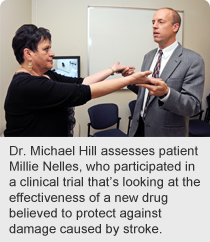
October 10, 2012
Photo by Paul Rotzinger
Before Millie Nelles underwent surgery in 2008 to have a brain aneurysm repaired, she made DVDs for her two daughters and her husband in which she said her goodbyes.
 Four months earlier, Nelles had brain surgery to correct a painful condition called trigeminal neuralgia. Although the subsequent procedure to repair the aneurysm was far less invasive, Nelles was less than optimistic about her prospects. Small strokes can sometimes occur during aneurysm repair and cause tissue damage.
Four months earlier, Nelles had brain surgery to correct a painful condition called trigeminal neuralgia. Although the subsequent procedure to repair the aneurysm was far less invasive, Nelles was less than optimistic about her prospects. Small strokes can sometimes occur during aneurysm repair and cause tissue damage.
“I honestly didn’t think my brain was going to be able to take any more,” she says.
Nelles had already suffered a stroke, and more than a year of living with trigeminal neuralgia had taken its toll.
When she was offered the chance to take part in a study looking at the effectiveness of a new drug believed to protect against the damage caused by stroke, she didn’t think twice.
“If I could help someone else by doing this, then I would have no hesitation,” she says.
Today, Nelles has the distinction of being Patient 001 in a landmark study led by Canadian researchers that has proven the safety and neuro-protective qualities of a new medication called NA-1.
Recently published online in The Lancet Neurology, the research findings show a 50 per cent reduction in the amount of brain damage sustained through aneurysm repair in people who received NA-1, compared to those who received a placebo.
“The results of this clinical trial represent a major leap forward for stroke research,” says Dr. Michael Hill of the Calgary Stroke Program at Foothills Medical Centre and the University of Calgary’s Hotchkiss Brain Institute (HBI).
“There have been over 1,000 attempts to develop such drugs, which have failed to make the leap between success in the lab and in humans.”
Hill, who is also a professor in the Department of Clinical Neurosciences, was the principal investigator of the multi-centre trial, which included more than 180 patients at 11 sites in Canada and three in the U.S. The drug was developed by Dr. Michael Tymianski at the Krembil Neuroscience Centre at Toronto Western Hospital.
Dr. John Wong, Nelles’s neurosurgeon who repaired her aneurysm and the man she credits with saving her life, was the principal investigator of the Calgary portion of the study. Wong says NA-1 works by disrupting one element in a “biochemical cascade” that leads to tissue damage following stroke.
Currently, the drug t-PA is the only widely approved acute stroke therapy. It works by unblocking the arteries to the brain, but it only works for a portion of stroke victims. It also has serious potential for side effects, including bleeding in the brain.
Researchers caution that more clinical trials are needed and it could be between three to five years before NA-1 makes its way into general use. Hill says it might one day be used by emergency responders to limit the damage caused by stroke.
For her part, Nelles has packed away the goodbye DVDs into “memory boxes,” together with some of the paperwork involved with the research project.
“When I went into the study I didn’t know if I’d get the real thing or a placebo,” she says of the randomized, double-blind trial.
“I found out a year later that I had received the drug – and that I didn’t have any strokes from the aneurysm repair. I absolutely believe it saved my life.”